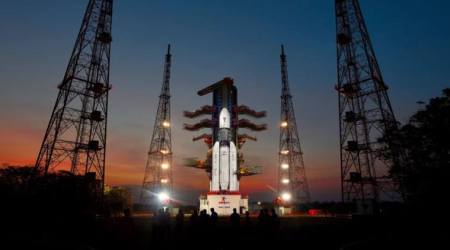 The GSLV Mk III, in the course of its first development flight, delivered the GSAT-19 satellite — the heaviest launched from Indian soil — to a geosynchronous transfer orbit following the launch at 5:28 pm. (Source: Twitter/ @isro)
The GSLV Mk III, in the course of its first development flight, delivered the GSAT-19 satellite — the heaviest launched from Indian soil — to a geosynchronous transfer orbit following the launch at 5:28 pm. (Source: Twitter/ @isro)
The Indian Space Research Organisation (ISRO) successfully launched its most powerful indigenous rocket, GSLV Mk III, carrying a 3,136-kg GSAT- 19 communication satellite, from the Satish Dhawan Space Centre in Sriharikota, in Andhra Pradesh, on Monday evening. The 43.43 metre-tall GSLV Mk III is a new, improved and powerful version of the GSLV rockets developed by ISRO, and features an indigenously developed cryogenic engine which provides a huge final thrust to the rocket after the initial solid and liquid fuel engine stages.
ALSO READ: Tech denied, ISRO built cryo engine on its own
The GSLV Mk III, in the course of its first development flight, delivered the GSAT-19 satellite — the heaviest launched from Indian soil — to a geosynchronous transfer orbit following the launch at 5:28 pm. The development of the rocket will enable ISRO to reduce dependency on European rockets for launching heavy communication satellites and will help the space agency position itself as an affordable provider of space launch facilities at a time of increasing privatisation of the space launch and service business.
“GSLV Mk III D1 successfully launches GSAT 19,’’ ISRO tweeted shortly after the launch. “Cryogenic stage performance is normal,’’ it said, after reporting normal performance in the liquid L110 engine stage and the S200 solid propellant stage. ISRO chairman A S Kiran Kumar described the launch as a step towards “self reliance’’ for India in the launching of heavy satellites.
READ: PM Modi, President Mukherjee applaud ISRO on GSAT-19, ‘heaviest’ satellite, launch
The cryogenic upper stage in the GSLV Mk III rocket, called the C25 engine, is an improvement on C20 cryogenic engines used in the GSLV Mk II rockets which entered operational phase in September 2016, after over 25 years of development, following the successful flight of the GSLV F05 with a 2,211-kg INSAT-3DR weather satellite. Developed by ISRO’s Liquid Propulsion Systems Centre, the C25 cryogenic engine carries more propellant (27 tonnes versus 12.5 tonnes) and higher engine thrust (19 tonnes versus 7.5 tonnes) when compared to the C20 cryogenic upper stage successfully tested on January 5, 2014. The GSLV Mk III is intended to launch heavy satellites in the four-tonne class into geo stationary orbits — a capability ISRO lacks since the basic GSLV can carry only around 2.3 tonnes.
READ: ISRO’s GSAT-19, GSAT-11 satellites set to revolutionise communications and Internet services
The C25 engine was developed indigenously by ISRO based on Russian cryogenic engines which the agency used during early phases of the development of the GSLV rockets. “Mastering this complex, high-performance cryogenic propulsion technology will go a long way in building self reliance for the Indian space programme,’’ ISRO has said with reference to the GSLV programme. The L110 liquid fuel engines — an improved version of the ISRO’s Vikas solid fuel engines — used in the second stage of the GSLV Mk III rocket are one of the heaviest earth storable liquid stages ever developed by ISRO.
The cryogenic stage on the GSLV is the third stage and uses liquid hydrogen as fuel and liquid oxygen as an oxidiser. Cryogenic stage is a highly efficient rocket stage that provides more thrust for every kilogram of propellant it burns compared to solid and earth-storable liquid propellant stages. The specific impulse achievable with cryo fluids is 450 seconds compared to 300 second for other fuels.
According to space scientists, cryogenic engines provide unprecedented power in terms of thrust to GSLV rockets in their final stages while keeping fuel loads on the rocket relatively low. Nearly 50 per cent of the power for GSLV rockets as they push into space comes from the cryogenic stage. India had first ventured on the path of obtaining cryogenic technology in 1992 with a two-pronged strategy of purchasing cryogenic engines from Russia and acquiring the technology from the US. Following the 1998 nuclear tests and sanctions imposed by the US on dual use technologies, the cryogenic technology was denied by the US.
ISRO used seven cryogenic engines sold by Russia for the early phase of its GSLV programme that began in 2001 while developing an indigenous technology parallelly. GSLV launches with Russian engines, including early operational flights, have had mixed success, with only two flights going perfectly to plan. The first GSLV flight with an indigenous cryogenic upper stage had failed on April 15, 2010 when a developmental flight, the GSLV-D3, failed.
In the absence of heavy lift rocket technology, India has been relying on France for launching its communication satellites. India is among six nations, apart from the US, Russia, France, Japan and China, to possess cryogenic engine technology — a key frontier in rocket science.

